Identification of basic/helix-loop-helix transcription factors reveals candidate genes involved in anthocyanin biosynthesis from the strawberry white-flesh mutant
- PMID: 29426907
- PMCID: PMC5807450
- DOI: 10.1038/s41598-018-21136-z
Identification of basic/helix-loop-helix transcription factors reveals candidate genes involved in anthocyanin biosynthesis from the strawberry white-flesh mutant
Abstract
As the second largest transcription factor family in plant, the basic helix-loop-helix (bHLH) transcription factor family, characterized by the conserved bHLH domain, plays a central regulatory role in many biological process. However, the bHLH transcription factor family of strawberry has not been systematically identified, especially for the anthocyanin biosynthesis. Here, we identified a total of 113 bHLH transcription factors and described their chromosomal distribution and bioinformatics for the diploid woodland strawberry Fragaria vesca. In addition, transcription profiles of 113 orthologous bHLH genes from various tissues were analyzed for the cultivar 'Benihoppe', its white-flesh mutant 'Xiaobai', and the 'Snow Princess' from their fruit development to the ripening, as well as those under either the ABA or Eth treatment. Both the RT-PCR and qRT-PCR results show that seven selected FabHLH genes (FabHLH17, FabHLH25, FabHLH27, FabHLH29, FabHLH40, FabHLH80, FabHLH98) are responsive to the fruit anthocyanin biosynthesis and hormone signaling according to transcript profiles where three color modes are observed for strawberry's fruit skin and flesh. Further, prediction for the protein interaction network reveals that four bHLHs (FabHLH25, FabHLH29, FabHLH80, FabHLH98) are involved in the fruit anthocyanin biosynthesis and hormone signaling transduction. These bioinformatics and expression profiles provide a good basis for a further investigation of strawberry bHLH genes.
Conflict of interest statement
The authors declare no competing interests.
Figures

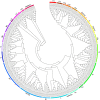

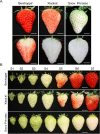
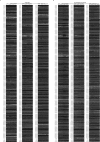
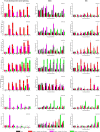
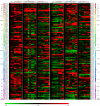

Similar articles
-
FvbHLH9 Functions as a Positive Regulator of Anthocyanin Biosynthesis by Forming a HY5-bHLH9 Transcription Complex in Strawberry Fruits.Plant Cell Physiol. 2020 Apr 1;61(4):826-837. doi: 10.1093/pcp/pcaa010. Plant Cell Physiol. 2020. PMID: 32016380
-
Application of a JA-Ile Biosynthesis Inhibitor to Methyl Jasmonate-Treated Strawberry Fruit Induces Upregulation of Specific MBW Complex-Related Genes and Accumulation of Proanthocyanidins.Molecules. 2018 Jun 13;23(6):1433. doi: 10.3390/molecules23061433. Molecules. 2018. PMID: 29899259 Free PMC article.
-
Protein kinase SnRK2.6 phosphorylates transcription factor bHLH3 to regulate anthocyanin homeostasis during strawberry fruit ripening.J Exp Bot. 2024 Sep 27;75(18):5627-5640. doi: 10.1093/jxb/erae250. J Exp Bot. 2024. PMID: 38808519
-
The underlying molecular mechanisms of hormonal regulation of fruit color in fruit-bearing plants.Plant Mol Biol. 2024 Sep 24;114(5):104. doi: 10.1007/s11103-024-01494-1. Plant Mol Biol. 2024. PMID: 39316226 Review.
-
Decoding the transcriptional regulatory mechanisms of basic helix-loop-helix transcription factors for fine-tuning target genes in rice.Plant Physiol Biochem. 2025 May;222:109696. doi: 10.1016/j.plaphy.2025.109696. Epub 2025 Mar 3. Plant Physiol Biochem. 2025. PMID: 40058237 Review.
Cited by
-
Genome-Wide Analysis of the ERF Family and Identification of Potential Genes Involved in Fruit Ripening in Octoploid Strawberry.Int J Mol Sci. 2022 Sep 11;23(18):10550. doi: 10.3390/ijms231810550. Int J Mol Sci. 2022. PMID: 36142464 Free PMC article.
-
Genetic modulation of RAP alters fruit coloration in both wild and cultivated strawberry.Plant Biotechnol J. 2020 Jul;18(7):1550-1561. doi: 10.1111/pbi.13317. Epub 2020 Jan 19. Plant Biotechnol J. 2020. PMID: 31845477 Free PMC article.
-
Recent advances in biosynthesis and regulation of strawberry anthocyanins.Hortic Res. 2025 May 21;12(8):uhaf135. doi: 10.1093/hr/uhaf135. eCollection 2025 Aug. Hortic Res. 2025. PMID: 40687928 Free PMC article.
-
An atypical HLH transcriptional regulator plays a novel and important role in strawberry ripened receptacle.BMC Plant Biol. 2019 Dec 27;19(1):586. doi: 10.1186/s12870-019-2092-4. BMC Plant Biol. 2019. PMID: 31881835 Free PMC article.
-
Comparative analysis of basic helix-loop-helix gene family among Brassica oleracea, Brassica rapa, and Brassica napus.BMC Genomics. 2020 Feb 24;21(1):178. doi: 10.1186/s12864-020-6572-6. BMC Genomics. 2020. PMID: 32093614 Free PMC article.
References
Publication types
MeSH terms
Substances
LinkOut - more resources
Full Text Sources
Other Literature Sources
Research Materials

